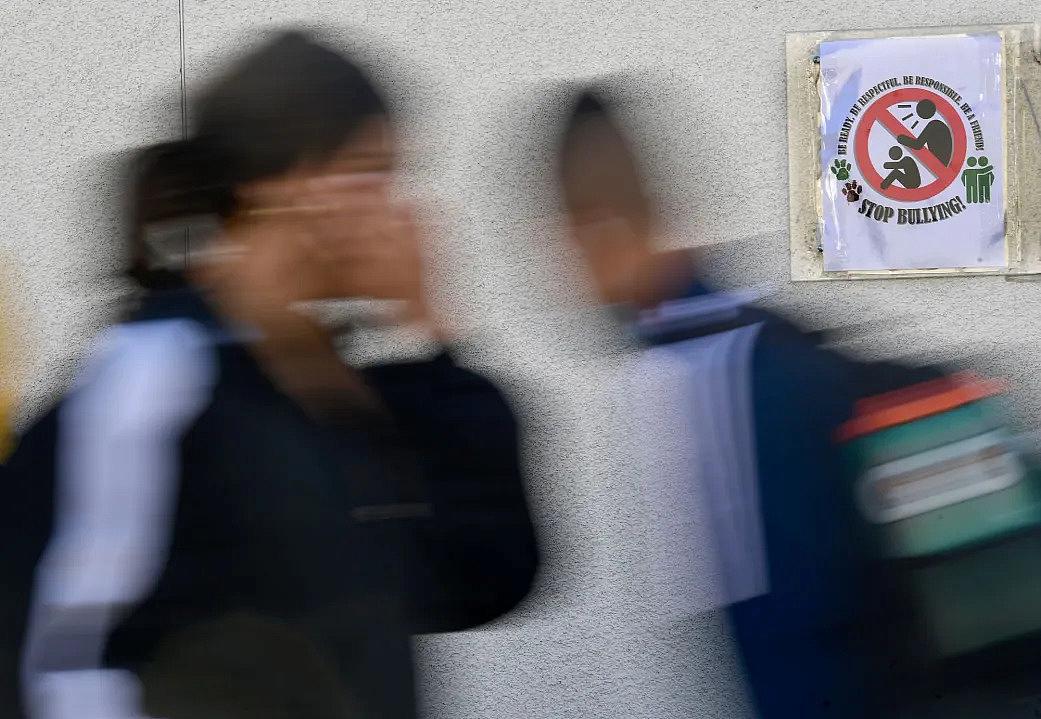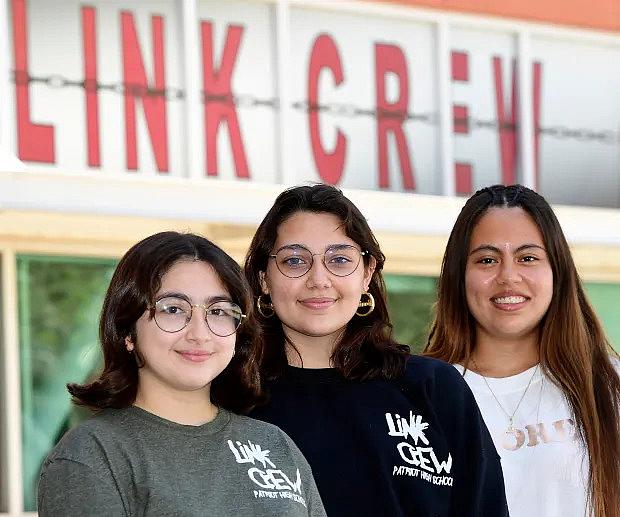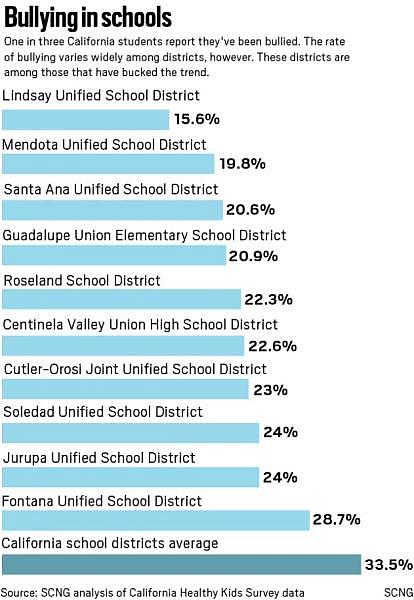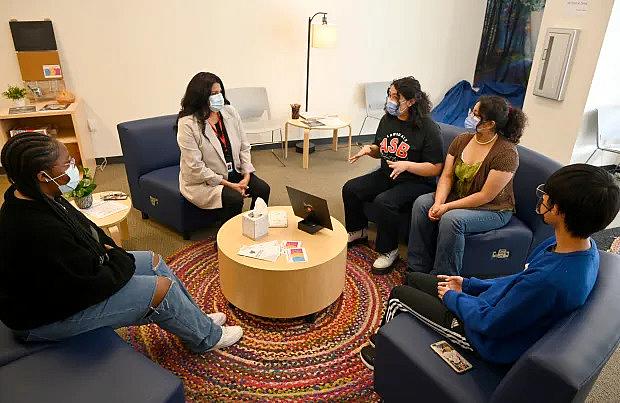What makes some California school districts so much better at preventing bullying?
This story is part of a 2021 Data Fellowship with the USC Annenberg Center for Health Journalism.
His other stories include:
Cyberbullying victims are more likely to suffer from depression. Here’s how to spot it and stop it.
How California students from marginalized groups are working to stop bullying
Family of Moreno Valley teen killed by bullies waits for court date
San Bernardino City Unified schools say anti-bullying program has 100% success rate

Students walk past one of the many anti-bullying signs posted around Harry S. Truman Middle School in Fontana on Thursday, March 17, 2022.
(Photo by Will Lester, Inland Valley Daily Bulletin/SCNG)
It’s not just “kids being kids.”
Bullying can cause a victim’s grades, emotional well-being and physical health to spiral, as in the 2017 case of a Danville girl filmed with her pants down in a bathroom, the video later posted to Instagram.
It can end in suicide, as in the 2017 death of a Yucaipa middle school girl whose family reported she had been repeatedly harassed and threatened with violence.
And it can end in criminal charges, as in the 2019 fatal assault of a 13-year-old Moreno Valley boy whose assailants were sentenced to probation for involuntary manslaughter.
THE EFFECTS OF BULLYING
Researchers say victims of bullying may experience:
- Difficulty making friends, maintaining successful romantic relationships
- Low self-esteem
- Higher chance of panic attacks or suicidal thoughts as an adult
- Depression
Bullies themselves may also suffer from depression and they are more likely to have low grades, abuse drugs and alcohol, or become violent adults, research shows.
Most bullying never goes that far, but repeated, aggressive behavior — physical or otherwise — by those with more power than the victim is commonplace in California schools. A new Southern California News Group analysis finds that about one in three middle and high school students surveyed reported being bullied or harassed over a five-year period.
“Parents have to unite and insist and insist and insist that what happened to us not happen to them,” said Felipe Salcedo, whose nephew, Diego Stolz, died three years ago after he was beaten by two classmates at Landmark Middle School in Moreno Valley. The family has sued the school district, saying it did not take their concerns about Diego’s bullying seriously.
“They could have done things to have stopped it,” Salcedo said.
With help from USC’s Center for Health Journalism, SCNG analyzed six years of anonymous, self-reported data from students across the state. According to the analysis, 33.5% of students surveyed said they’d been bullied or harassed between 2016 and 2020. But bullying rates vary widely school district to school district — from a low of 11% to a high of 59% of students reporting incidents of bullying — with those districts showing the lowest rates making anti-bullying efforts a priority.
Selena Victorio, left, a freshman, speaks with Elizabeth Diaz, right, of Project Kinship at Saddleback High School in Santa Ana on Friday, March 18, 2022. Project Kinship offers a variety of services for youth which include: mediation support, restorative circles, arts and healing, social-emotional support, and many others. (Photo by Mark Rightmire, Orange County Register/SCNG)
Mental health matters
Among districts with lower levels of reported bullying, there’s a focus on social-emotional learning, or “SEL,” according to interviews with educators at 10 such districts across the state.
SEL emphasizes students getting in touch with their own emotions and mental well-being and having empathy for others.
“This actually moves into the core purpose of what schools are supposed to do for society. (They are) supposed to create a society that cares, that supports and helps people,” said Ron Avi Astor, a professor of social welfare at UCLA. “It puts schools out in front of what we hope society will be in 10 years.”
California school districts are increasingly focusing on their students’ mental health — especially in the two years since the start of the coronavirus pandemic. A 2021 SCNG analysis found that while suicide rates fell in the greater Los Angeles region in 2020, they went up among minors.
“Anxiety rates, depression rates are up, especially with social media. Suicide rates are up across the country,” said Joe Ochoa, director of state and federal programs and safety coordinator for Mendota Unified in Fresno County, where less than 20% of students reported being bullied, according to the new SCNG analysis. “So, several years ago, with additional funding from (the state), we said this was an area we needed to improve on.”
The district increased spending on mental health programs in the district, along with changing school discipline programs to focus on the roots of problems and making restoration to the injured parties, rather than simply punishing offenders.
Cutler-Orosi Joint Unified in Tulare County, meanwhile, is one of several districts interviewed using the Second Step programs from the Seattle-based nonprofit Committee for Children to train all its employees in social-emotional learning.
“When COVID hit, we understood the need for social-emotional learning and that our students would need support,” said Javier Gomez, a positive behavior intervention and supports coordinator for the Cutler-Orosi district. “It was so important at that time for staff to have those resources so that when students came back to school (following pandemic-related closures in 2020), we were ready for them.”
HOW WE DID THE ANALYSIS
The Southern California News Group looked at how many seventh, ninth and 11th graders anonymously said they had experienced harassment or bullying on the California Healthy Kids Survey from 2014 through 2020. The survey is given to students in about three-quarters of California school districts. We excluded districts with fewer than 1,000 students as not being representative. The average California public school district has about 5,478 students, according to the California Department of Education.
This isn’t just touchy-feely stuff. When students have their mental and emotional health needs met, studies show they do better academically, are more likely to graduate, get higher test scores and have fewer disciplinary issues.
“You want your child to be in a safe and positive learning environment to really ignite student achievement,” said Sonia Llamas, the assistant superintendent of K-12 School Performance and Culture at Santa Ana Unified in Orange County, where about 20% of students reported being bullied, according to SCNG’s analysis.
School districts with lower rates of bullying have put those new mental health skills to work, looking at why bullies do what they do and getting them to understand the impact of their behavior.
“You have to allow every student to have a voice,” said Ayesha Brooks, the director of multi-tiered system of supports at Fontana Unified in San Bernardino County. “A lot of the problems that we were having on campus, it really came out in circles.”
After an incident in Fontana schools, where students reported a slightly lower-than-average rate of bullying in SCNG’s analysis, students get together in “circles,” or small groups, to discuss what happened and why.
“We taught empathy, we taught social skills,” Brooks said.
Jurupa Unified in Riverside County, with a 24% bullying rate per the SCNG analysis, has instituted a youth court program. Instead of being suspended for bullying and other disruptive behaviors, offenders go before the student volunteer-run court.
“It’s basically about giving kids who make mistakes at school a second chance,” said Arely Jimenez, 17, a senior at Jurupa Unified’s Patriot High School. “We ask them questions like ‘what do you want to do when you grow up, how do you think this affects your future job prospects?’ And that causes them to reflect and think on their future.”
Those who come before the district’s court join the jury for later cases to help them develop empathy with their fellow students and understand the impact bullying has had on them.
Patriot High School’s seniors Alisson Valle, left, and Kailyn Guerrero, center, are both members of the school’s Link Crew while Youth Court member and, former Link Crew member, Arely Jimenez, right, stands along side at the Jurupa Valley school on Wednesday, March 16, 2022. The crew is one of the ways that Jurupa Valley says they’ve been able to lower bullying levels in their district. (Photo by Will Lester, Inland Valley Daily Bulletin/SCNG)
Jurupa Unified is also one of a number of districts with lower-than-average bullying rates where upperclassmen mentor freshmen, helping them navigate the transition to high school and giving them someone to talk to when there are problems.
“We take the time to let kids know they’re not alone and if they’ve got a problem, they’ve got someone to talk to,” said Patriot High senior Alisson Valle, 18. “We don’t judge. Everything they say to us is confidential.”
UCLA’s Astor said the new focus on emotional intelligence in schools is working. He pointed to the dramatic drop in student fights over the past two decades. According to the National Center for Education Statistics, the percentage of high school students who reported being in a fight dropped from 31% in 2009 to 22% in 2019.
“It’s kind of crazy, and we don’t have an awareness of that” drop in on-campus violence, Astor said.
Systems of support
In addition to developing programs to support student mental health, districts with fewer reported incidents of bullying hired more counselors. In some cases, many more.

Both the American School Counselors Association and the California Association of School Counselors recommend one counselor per 250 students.
“At one point, California was well over 1,000” students per counselor, said Jill Cook, executive director of ACSA.
Nowadays, the average California district has one counselor per 572 students, according to a February report by ACSA. Only Arizona, Illinois, Michigan and Minnesota have worse ratios. Nationwide, the average school has one counselor per 415 students.
“Historically, we have never had the political will in California to fund school counselors, school psychologists and social workers,” said Loretta Whitson, executive director of CASC. “It is our norm, so the people who make those hiring decisions don’t understand what it’d be like if we were fully funded and operational.”
Districts with lower student-to-counselor ratios see counselors getting out of their offices, doing more than offering guidance on colleges and careers.
“The counselors do have a special bond with the students here,” said Karina Romero, 13, an eighth grader at Fontana Unified’s Harry S. Truman Middle School. In 2020-21, Truman Middle had one counselor for every 519 students, slightly better than the state ratio.
“You feel safe, you have reassurance, they ask if you’re OK, they ask if you’re feeling fine,” Romero said. “They do check up on us. The counselors do care about your mental health and pretty much anything about your life.”
Dramatically staffing up this past year, Santa Ana Unified is one of the few districts in California with the 250-to-1 student-counselor ratio, down from 600-to-1 before the pandemic. For the first time, even the district’s elementary schools have counselors.
“You can imagine now how many more points of contact the counselors have” with students, enabling them to do more than offer the most basic services, Llamas said.
The district used a mix of state funding, federal COVID-relief funds, partnerships with outside agencies and grants from the city of Santa Ana to bring on extra counselors.
Lawndale High School students chat with social worker, Celeste Lopez in the school’s wellness center, in Lawndale on Wednesday, March 16, 2022. Some school districts offering places where students have easy access to counselors and mental health support has shown dramatically lowered bullying rates in self-reported student surveys. (Photo by Brittany Murray, Press-Telegram/SCNG)
In Los Angeles County, Centinela Valley Union High School District, where less than 23% of students have reported being bullied, increased access to counselors with a “wellness center” in each of the district’s four comprehensive high schools. There, students can connect with counselors and social workers easily.
“They have been hugely successful,” district spokeswoman Cammie Vogel said. “The students utilize them on a regular basis.”
At each site in Tulare County’s Lindsay Unified, students are connected with individual employees who mentor them. Counselors at each site also moderate groups of students to resolve conflicts as they come up.
“It really is about creating a climate to make learners feel valued and safe,” said Brian Griffin, the district’s assistant superintendent of Student Support Services. “That’s been a concerted effort.”
Like other districts interviewed, Lindsay Unified officials increased access to mental health services in response to community requests.
“For many years, the community has said ‘we need counselors,’” Griffin said.
There are signs that student-to-counselor ratios may start to improve across the state and nation, according to Cook.
“A lot of the COVID recovery money has gone specifically to mental health supports in schools,” she said. In fact, demand may actually be exceeding supply. “We have a pipeline issue nationally,” she added. “Before, we’ve never had that.”
Focus on anti-bullying
Beefed up anti-bullying policies and procedures are common among districts with lower rates of bullying.
Districts say it starts with making it easier to report bullying.
Soledad Unified in Monterey County, for instance, has a special mobile app to report bullying, posts QR codes around its campuses linking to its bullying reporting portal, and links to the portal are pre-installed on district devices. Less than a quarter of the district’s students have reported being bullied, the SCNG analysis found.
Jurupa Unified and other districts also use software to monitor student use of district devices and flag problematic behavior.
The next step is enhanced training within schools.
“The training is a critical component, so they’re aware of how to refer students, how to address behavior,” Santa Ana Unified’s Llamas said. In Santa Ana Unified, teachers, activity monitors and after-school program monitors are all trained to spot and respond to bullying.
In other districts, all staff and even all students receive anti-bullying training. And that includes teaching students to not stand by and watch as something happens.
“The most courageous thing you can do is ask for help,” Llamas said. “If your friend can’t ask for help, feel free to advocate on their behalf and get them help.”
This sort of anti-bullying training for students leads to cultural change.
“There’s a tipping point when it becomes the ‘in’ thing to be anti-bullying, instead of it being the ‘in’ thing to be a bystander,” the California Association of School Counselors’ Whitson said.
No district interviewed for this story did everything listed. But all did some combination of the techniques. And, according to their surveyed students, the efforts paid off with lower rates of bullying compared to state average.
This story is part of a 2021 Data Fellowship with the USC Annenberg Center for Health Journalism.
Staff Writer Nikie Johnson contributed to this report.
[This article was originally published by The Sun.]

